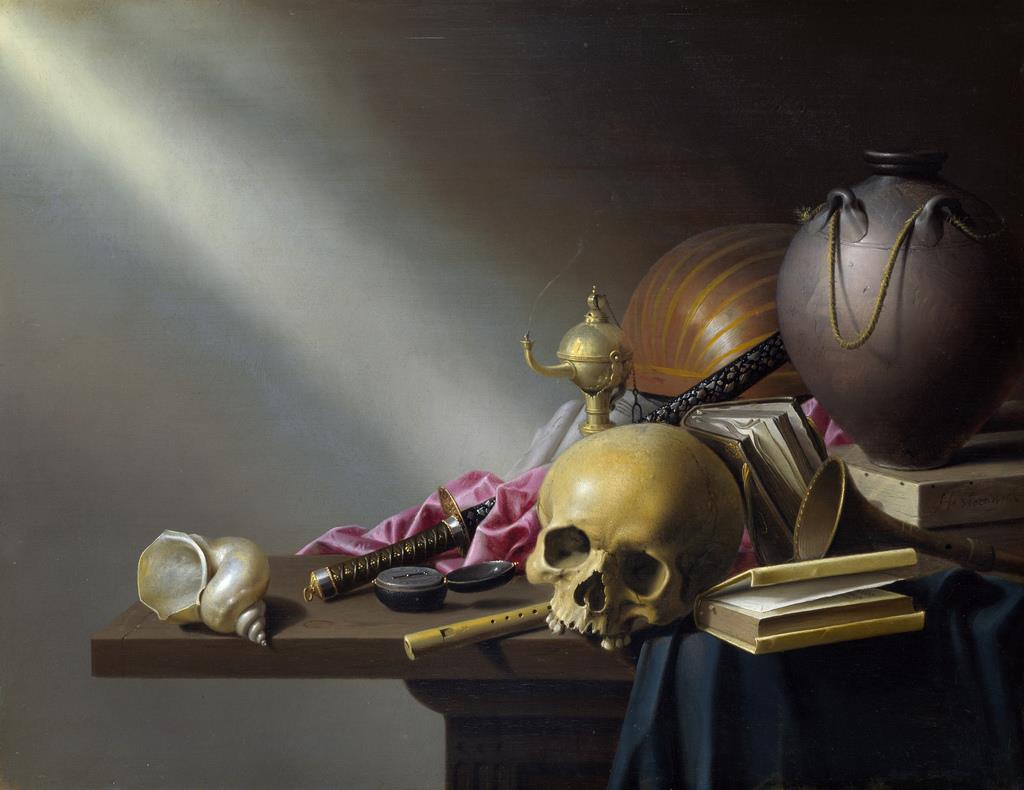Maika Bahr and Professor Martha Peacock, Art History (Comparative Arts and Letters)
Introduction :
The relationship between the Dutch Republic and Japan during the seventeenth century provoked early Orientalist feelings that were manifested in still-life paintings. Harmen Steenwyck’s Still Life: An Allegory of the Vanitas of Human Life from 1640, depicts an intricate, Japanese sword at the center of a still-life table scene surrounded by objects that allude to the theme of vanitas, like the yellowed skull and pocket watch, and other objects that signify the romanticized Orient, like the supple fuchsia-colored silk and sparkling seashell (Fig. 1). Although still-life paintings are usually decoded with an emphasis on the theme of vanitas, I chose to demonstrate how this particular piece conveys a sense of Dutch superiority in military prowess and commercial success. This degradation of Japanese culture is achieved through the work’s focus on the sword as a stolen object, the religious and militaristic connotations attached to the sword, and the general over-idealization of the Orient.
Methodology :
My research began with extensive study at Brigham Young University’s Harold B. Lee Library in the fall semester of 2017. After conducting this preliminary research, I wrote a ten-page paper summarizing said research, proposing a hypothesis, and highlighting the points of interest that I aimed to study further in Europe. Using the money from the ORCA grant, I was able to travel to the Netherlands. While in The Hague, the distinguished Dutch city, I took some time to visit the Netherlands Institute for Art History, also called the RKD, to look through their vast archives of art historical images and texts. When I searched through their comprehensive records of Dutch art, I was able to find two other still-life paintings by Steenwyck that depicted the same Japanese sword. Both paintings were not easily accessible to the public – one of them is in a private collection, and the other is in an art museum in Leiden which is currently closed for renovation. By finding the records of these pieces, I was able to solidify my argument that this sword was indeed stolen from Japan since this unknown artist had easy access to this still-life prop. Additionally, I was also able to visit three exhibitions in England and France that showcased some of the objects that were brought to Europe from Japan during the seventeenth century. This allowed me to broaden my perspective of the kinds of artifacts that were imported and allowed me to know what kinds of foreign objects to look for in other works.
Results :
Discovering the Japanese sword’s appearance in other works strengthened my argument that the sword was an illegally stolen object. If a relatively unpopular and unknown artist such as Steenwyck had access to such a valuable commodity, this sword had to have been one that was smuggled out of the country–it was absolutely not a diplomatic gift. The sword symbolizes the weak and underdeveloped Japanese weaponry and military in comparison to the civilized Dutch military with advanced war technology. Also, using the two other still-life paintings that depicted the Asian sword, I was able to effectively produce an iconographic reading of the items that frequently appear alongside the sword, such as the shells, oil lamps, and foreign jars. I concluded that these other exotic objects accentuated the swords “Otherness,” and the inclusion of foreign luxuries from different lands on the same picture plane exemplified the Dutch Republic’s possession and control over their non-Western allies.
Discussion :
Although post-colonial interpretations of still-life paintings from the Golden Age of the Dutch Republic are abundant, there is little research on the artist Harmen Steenwyck and his contribution to the still-life genre. Moreover, there are surprisingly few art historical discussions of the relationship between Japan and the Netherlands. I contributed to the post-colonial discussion of still-life paintings by highlighting this unique relationship between the two countries and by using the works of an understudied artist. I was able to further expose the condescending attitude of Europeans towards their Asian allies through my iconographic reading of the painting and assertion of the swords’ stolen nature.
Conclusion :
The ORCA grant allowed me to travel to the Netherlands and learn how to conduct archival research from Professor Martha Peacock. The results from this experience were beneficial to my argument and strengthened my essay. After returning home, I was able to workshop my paper with peers and professors to compose a longer, more complete report. I showcased my research at the Humanities ORCA Symposium and later presented it as my senior thesis for the Art History Capstone. I hope to continue researching the cross-cultural connections between Japan and the West and advertise Japan’s contribution to Western culture.
Figure 1: Harmen Steenwyck, Still-life: An Allegory of the Vanities of Human Life, 1640

